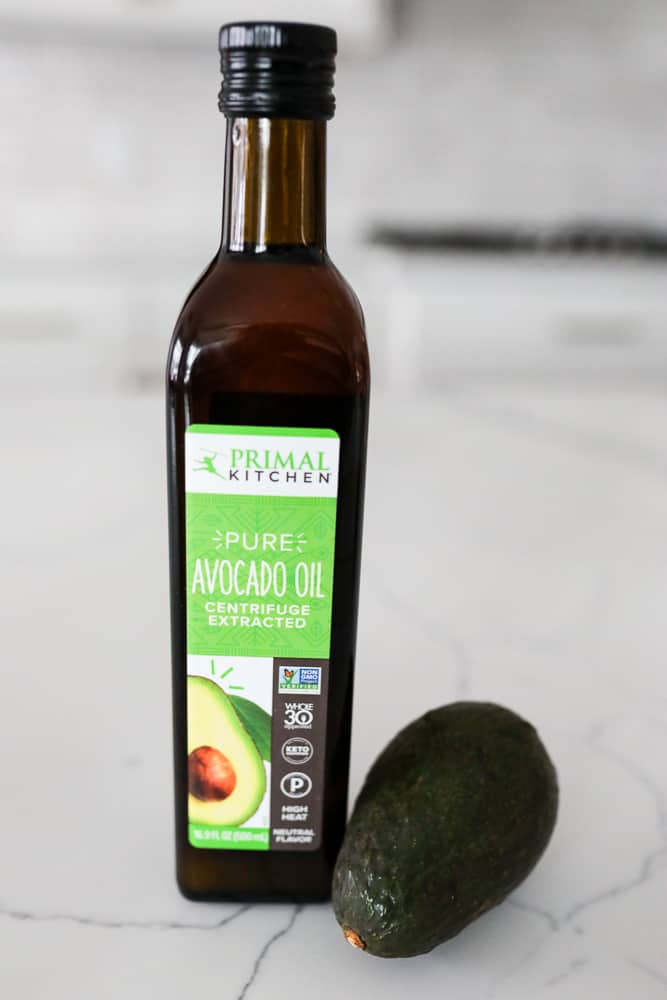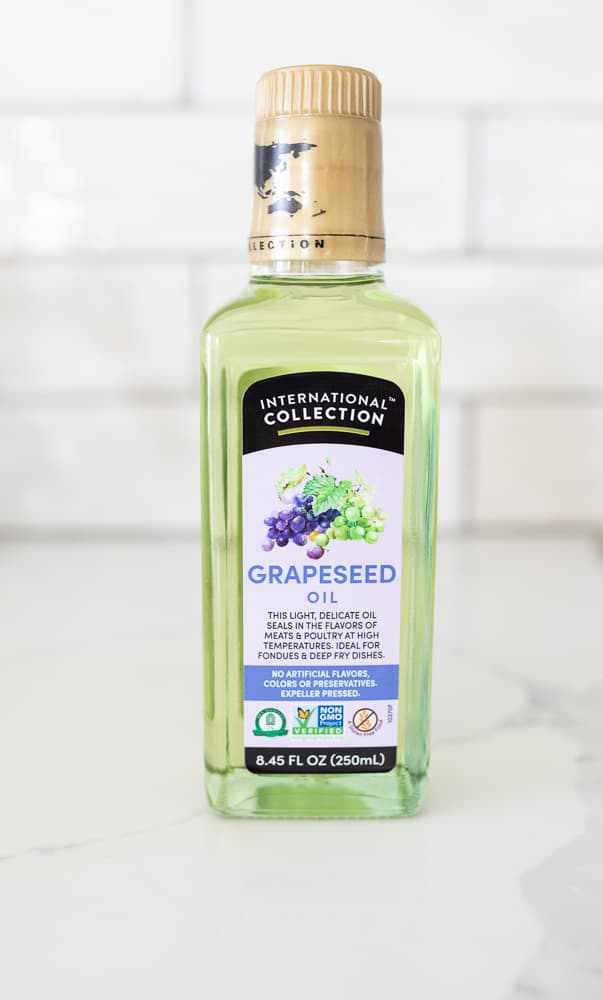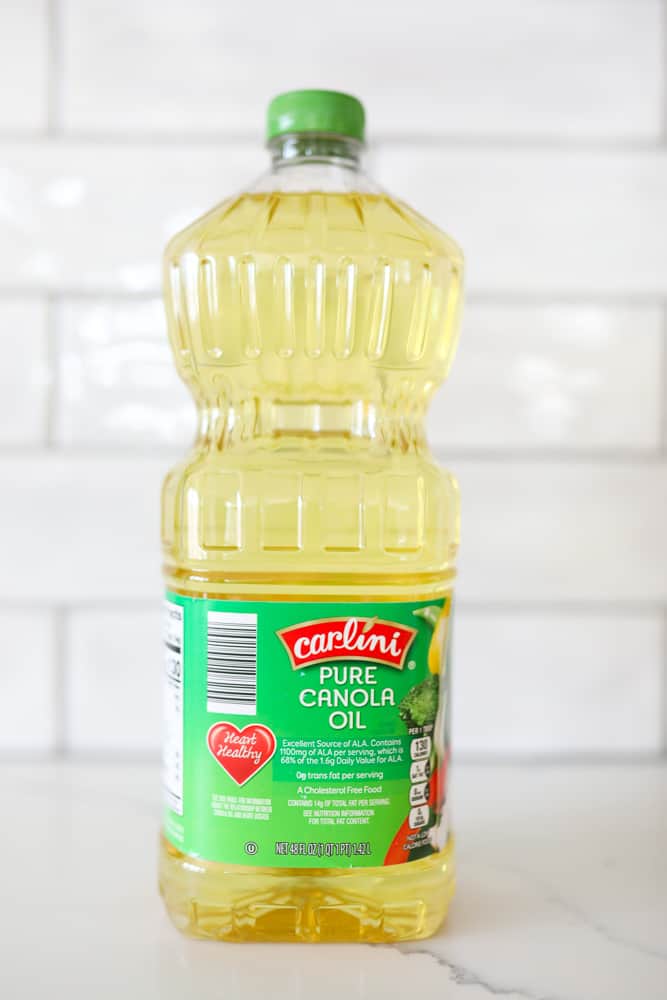It doesn’t happen often that a recipe calls for an ingredient that won’t add flavor to the dish. So you’ll know that when a recipe calls for ‘neutral oil,’ there is an important reason for it.
Imagine using peanut oil to bake a cake. It’s really not enjoyable. Trust me, I’ve been there and done that. Over time I’ve experimented, failed, and ultimately succeeded at understanding which oils work best for specific recipes.
In this article, I’ll explain the best use cases for a few of the most popular neutral oils, tips on how to pick and choose for yourself, and a few of the hard lessons I’ve learned along the way so that you don’t have to find out for yourself.
Table of Contents
What Is a Neutral Oil?
Neutral-tasting oil is a bland and tasteless medium used to cook other ingredients without adding any additional flavors of its own. Other fats and oils are usually integral to the final recipe’s flavor and taste. But neutral oil maintains the sanctity of the ingredients’ flavors by staying out of it.
The best part about neutral oil is its versatility.
They can be used for frying, dressing, baking, sauces and other general cooking uses. Since a neutral oil doesn’t add flavor to the food, they’re ideal for cooking with delicate flavors that can otherwise be easily over-powdered.
The 5 Best Neutral Oils
Although none of these oils offer a strong flavor, there are several meaningful differences from one to the next. The smoke point, cost, color, nutritional value, and potential allergens are a few factors worth considering when picking the right oil for any dish.
Neutral Oil Chart
| Neutral Oil | Smoke Point (refined) | Est. Cost / Fl Oz | Good For |
| Avocado Oil | 520°F | $0.40 | Searing, grilling, roasting |
| Sunflower Oil | 486°F | $0.30 | Sautéing, seafood, dressings |
| Grapeseed Oil | 420°F | $0.22 | Dressings, sauces, roasting |
| Vegetable Oil | 428°F | $0.10 | Deep frying, baking |
| Canola Oil | 428°F | $0.11 | Dressings, frying, baking |
Best Neutral Oil by Cooking Method Chart
| Cooking Need | Best Neutral Oil | Best Substitute |
| Baking | Canola Oil | Vegetable Oil |
| Searing | Avocado Oil | Sunflower Oil |
| Grilling | Avocado Oil | Sunflower Oil |
| Frying | Canola Oil | Vegetable Oil |
| Sautéing | Sunflower Oil | Grapeseed Oil |
| Roasting | Avocado Oil | Grapeseed Oil |
Avocado Oil
Avocado oil is considered one of the healthiest oils since it is high in monounsaturated fat (typically considered a healthy or good fat). Made from oil-rich avocados, it adds a nice creaminess to the dish despite its neutral flavor and aroma.

Both refined and cold pressed avocado oil has a higher smoke point, 520°F and 480°F respectively, than most other plant-based cooking oils. So they can be used in a variety of cooking methods including searing, grilling and roasting. It also works well as a salad dressing and as a substitute for butter in baking cakes.
Avocado oil is relatively expensive, usually priced at ~$0.40 per fluid ounce. In my opinion, it’s worth every cent. Though costly, avocado oil is the most versatile of all neutral oils.
When buying avocado oil, try and look for cold-pressed varieties, as the oil is extracted without any exposure to heat. This helps the oil retain its nutrient value. Studies have shown that avocado oil is rich in antioxidants and helps reduce cholesterol. Even unrefined avocado oil has a very high smoke point of 480°F.
Given its high price, many oils on the market are adulterated or rancid. So make sure you read the ingredient on the label carefully before buying.
Sunflower Oil
Sunflower oil is made from sunflower plant seeds. It has a mild flavor that won’t overpower other ingredients and a relatively high smoke point of 486°F, making it another great choice for a neutral oil.
Sunflower oil is easy to find on grocery shelves as it is a common pantry staple in most households. This oil is a good option for regular cooking as it is reasonably priced at around ~$0.30 per fluid ounce.
Refined sunflower oil is ideal for searing and sautéing anything. It is commonly used on ingredients like shrimp, salmon, and lobster because it does not mess with their delicate flavors. Unrefined, or cold pressed sunflower oil is commonly used in salad dressings and has a buttery nutty flavor (not neutral).
Apart from its subtle flavor, this oil is an excellent source of vitamin E and antioxidants.
Store the oil in a cool, dark corner of your kitchen to ensure that it doesn’t go rancid. Also, try to use it up within a year, as seed-based oils tend to get spoiled quickly if not stored at the right temperature.
Grapeseed Oil
Grapeseed oil is a light green-colored oil made from the tiny seeds of grapes. Ideal for frying, baking, and even making dressings, it is the most commonly used neutral oil and a top pick for most professional chefs.

It has a smoke point of 420°F and a clean flavor that does not interfere with the flavors of other ingredients, which makes it great for sautéing and stir-frying delicate foods. Priced at around ~$0.22 per fluid ounce, it is often used to make dressings like vinaigrette since it is more affordable than EVOO and adds the same shine to salads and sauces.
Grapeseed oil is also considered a heart-smart oil for its balanced fatty acids and is rich in vitamin E and omega-6.
Interestingly enough, grapeseed oil is actually a byproduct of the wine-making process. It is extracted from leftover seeds after the grapes have been pressed for wine. So it is also considered to be a sustainable choice of oil.
Grapeseed oil is my go to oil for searing sous vide chicken breast.
Vegetable Oil
Generally, vegetable oil is a blend of multiple refined seed and nut oils such as soybean oil, palm oil, sunflower oil, and canola oil. But it is truly neutral in flavor and smell.
Vegetable oil is very accessible and easy to find at any grocery store. Its bland taste makes it ideal for dishes like tempura and even for baking sponge cakes and steamed buns.
It usually has a smoke point of around 428°F, which is great for deep frying and high-heat sauteing and searing. As a bonus, it is also pretty inexpensive and priced around ~$0.10 per fluid ounce. But unfortunately, it is not one of the healthier options available, especially in comparison to oils like avocado and grapeseed oil.
It is very important to know what’s in your vegetable oil, so make sure you read the label carefully before buying it. This way, you can avoid allergic reactions or skip particular oils you’re not fond of.
Canola Oil
First of all, let’s be clear that there is no such thing as a canola plant. This neutral oil is extracted from the seeds of the rapeseed plant.

It is one of the popular choices for a reason. It has a high smoke point of 428°F and is inexpensively priced at around ~$0.11 per fluid ounce. You can use it for frying, sauteing, baking, making sauces, and dressing, among many other uses.
Canola oil is also a healthier option than most oils as it is low in saturated fats. It is also a good source of monounsaturated fats, omega-3, and fatty acids. This makes it a heart-healthy oil. Canola oil offers the best combination of cost and versatility.
It is very similar to vegetable oil in terms of flavor and smell. But it is often given preference over vegetable oil as we know exactly what’s in it as opposed to the ambiguity in vegetable oil.
Canola oil also make it onto our best oil for fried chicken list.
When to Use Neutral Oil
Neutral oil is mostly used when trying to preserve the flavors of the ingredients, even after cooking them. A lot of recipes call for strong and flavorful oils like peanut oil, coconut oil, and mustard oil. This is primarily because the flavor of these oils complements or elevates the other ingredients while cooking.
On the other hand, some dishes and preparations require the opposite. Where the cooking medium (the oil used) should only aid in the browning and cooking of the ingredients, and that too without adding its own flavor.
A good example is baking. Most baking recipes you’ll read call for neutral-tasting oil. This is because baking is usually done using delicately flavored ingredients which can easily be overpowered by other flavors.
Similarly, most salads are made using fresh and light ingredients like lettuce, fresh herbs, and bell peppers. And these ingredients don’t have very strong or bold flavors. So salad dressings are made using neutral oils.
Recap
Hopefully, you were somewhat familiar with these oils. Now you also know which ones are considered neutral in taste and what cooking method they are ideal for.
Remember to use avocado, grapeseed, canola, vegetable, or sunflower when a recipe calls for neutral oil. And stay away from stronger flavored oils like peanut oil, mustard oil, and coconut oil.
If you’re curious about which oils are best for searing steak, read 5 Best Oils for Searing Steak (+ 1 To Avoid). Our #1 choice may surprise you!
Neutral Oil FAQs
Yes, pure vegetable oil is a neutral oil. What we refer to as pure vegetable oil is often a blend of multiple seed, nut, and fruit oils like soybean oil, canola oil, and sunflower oil. It is considered to be neutral in taste, aroma, and color, making it a great option for any recipe that calls for neutral oil.
Given the variety of olive oils that exist in the market, there isn’t one clear answer to whether olive oil is neutral flavored. Extra virgin olive oil is not neutral flavored oil. Since it is not treated or extracted in the presence of heat, the olive flavor can be very dominant. However, more refined and processed varieties of olive oil, like light refined olive oil, have a more neutral flavor.
Light refined olive oil is the most neutral-tasting olive oil. Do not confuse it with extra virgin olive oil, which has a very strong flavor. Light olive oil is processed in heat to neutralize its flavor, giving it a lighter color and taste. It is also a cheaper option as compared to most olive oils.

